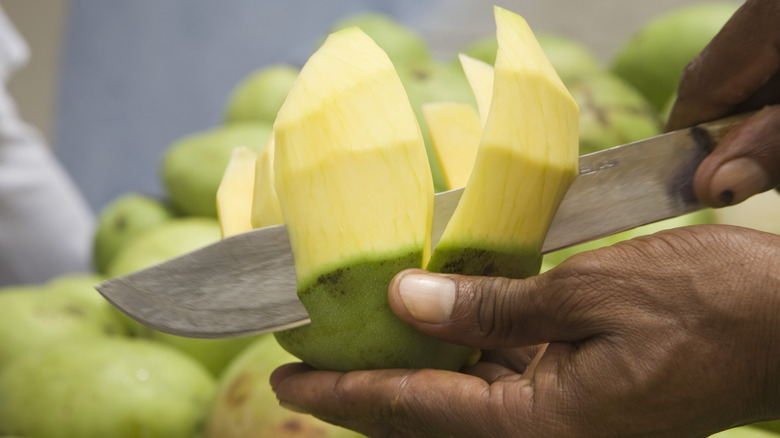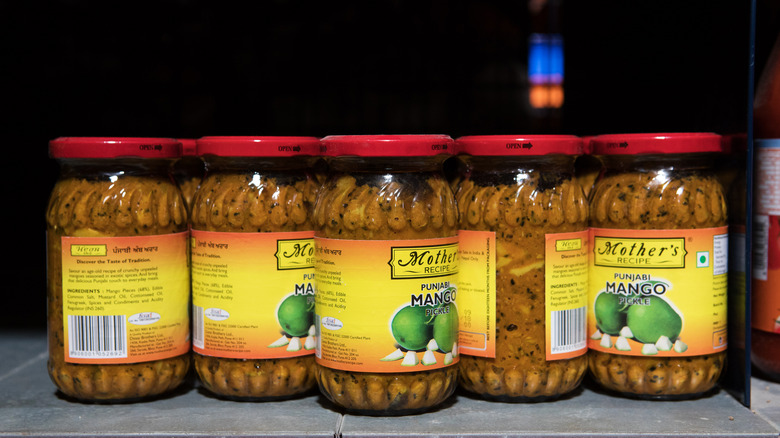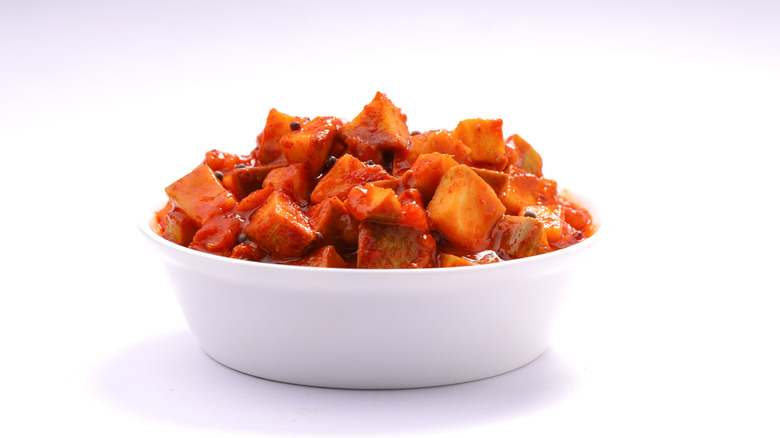The Sweet And Spicy Condiment To Make With Unripe Mangos
For people who neither live in a tropical climate nor have a backyard with two to three mango varieties, they have to be content with buying a mango that has probably been ripened en route. Sure, there are some compromises in quality but at least it is possible to source it.
In comparison, unripe (or green) mangos are a bit harder to find because most retailers and customers value ripe, juicy mangos. This is a shame because unripe mangos are the basis for a delicious South Asian pickle or condiment known as mango achaar (achaar being the Hindi word for pickles). It is a balance of tangy, sweet, and spicy flavors thanks to its list of ingredients, which consists of unripe mangos, aromatic spices, salt and oil. It also challenges what people assume is a "pickle" as there is no vinegar-salt brine here.
In South Asian cuisine, mango achaar, just like lime achaar, is a standard accompaniment to rice dishes. You can also just scoop and eat it with papadams but be prepared for your mouth to pucker from the tangy aftertaste.
There are as many mango achaar recipes as there are households
In general, there are three main components to making achaar. The first part consists of cutting the mangos into small chunks or thin strips and placing them in a sterilized jar. Some people may remove the skin, while others do not. It comes down to personal preference. Traditionally, the mangos are dried outside in the sun to soften them, which is possible since they are from a region with plenty of sunshine. If this is not possible where you are, feel free to skip it.
The second part is all about incorporating the spices and this is where there is a lot of variation. The spices can include fenugreek seeds, fennel seeds, nigella seeds, peppercorn and turmeric powder. Coat the pieces of mangos with the spice blend and a heap of salt. Do not skimp on the salt because this is what will transform the texture and taste. For example, 2 1/4 pounds of unripe mangoes will require about one cup of salt.
The final step is to incorporate the oil, which is typically mustard oil. The oil can either be poured into the jar as is, or it can be heated up first until it smokes and then cools down. Make sure that the oil covers all the mango pieces and wait for about a month for the flavors to develop.
No, you cannot make mango achaar with ripe mangos
There are reasons why we use unripe and not ripe mangos to make achaar. First, unripe mangos have a tangy, slightly sour taste, which balances the spices and oil to create the desired flavor profile.
Second, unripe mangos have a firm and crisp texture, which make them ideal for pickling. The firmness allows the mango pieces to retain their shape during the pickling process, which provides a satisfying bite if not crunch. This is the same reason why vegetables like cucumber make for ideal pickles, including the Korean version, oi muchim. In comparison, ripe mangos are soft and juicy and will become too mushy at the end of this process.
But don't worry, there is an alternative if you find yourself with a glut of mangos. Try making mango chutney instead, which has a more jammy texture. You can eat the mango chutney with most Indian food as well as cold cut sandwiches or a cheese platter.


